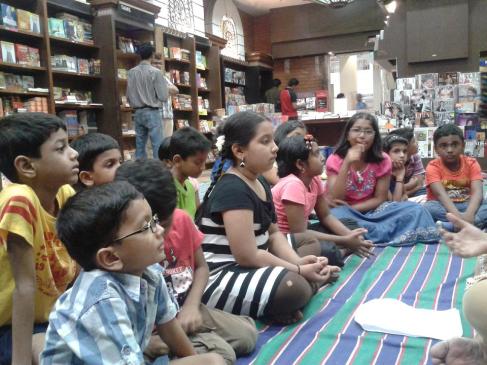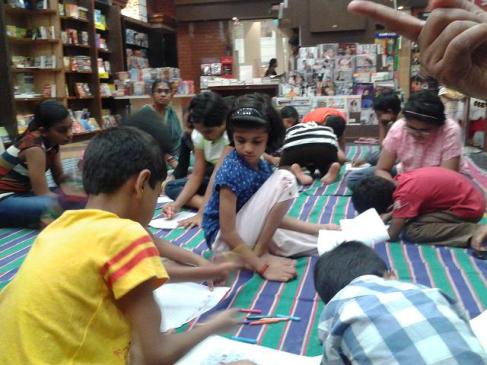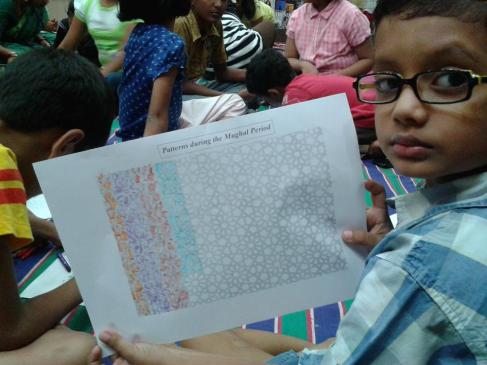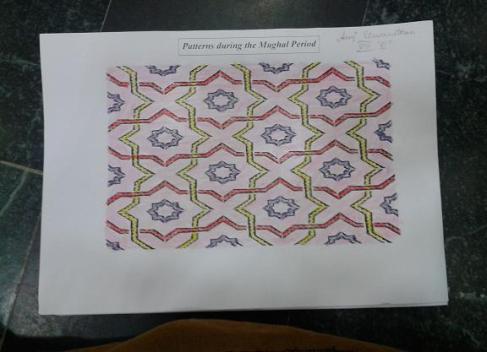Not that anyone knew anything about Raja Raja Chozha the First, of course. Well, not right away, and I tried to enlighten them. That’s the whole point of a Historical Storytelling workshop, after all. But before that came another story.
 Once the kids (and parents assembled ), we began with a story that has connections to an important event next week. October 2nd, in fact. My story had to do with a certain American journalist called Web Miller, who had a terrible time getting to a tiny village in India, to witness an event that would change the whole of the Freedom Movement.
Once the kids (and parents assembled ), we began with a story that has connections to an important event next week. October 2nd, in fact. My story had to do with a certain American journalist called Web Miller, who had a terrible time getting to a tiny village in India, to witness an event that would change the whole of the Freedom Movement.
The Salt Satyagraha.
But before the story proper, I distributed a tiny packet to each of the kids.
They were pretty curious – but I told them not to open them, and they had enough self-control not to.
As we went through the whole story, most of the kids listened pretty intently. And yet – I noticed something: they knew key characters like Gandhiji and Sarojini Naidu. They even remembered the Salt Satyagraha – or something that seemed vaguely familiar. But there was a problem, They knew the names. They knew the terms. They even remembered the significance of October 2.
But no one knew what exactly the Salt Satyagraha was!
I sort of sensed the disconnect, as the story went along. They managed to stick with it until the end, but when the story was done, the reaction was more of polite interest. The story was ok – but the History part didn’t engage them.
And then, I asked them if they still had the little paper packets I’d given them at the beginning of the session. Everyone did.
“Now, open them,” I said. “Slowly.”
The paper was folded well, and to their credit, they opened them very carefully. There were some words written in it.
Inside – was a little pinch of salt. With something written on the paper.
And then, suddenly – a light bulb went off.
I could almost sense the way they put everything together – the pinch of salt in the paper, with the text – and realization came to them. That’s when the questions started.
“But this is salt!” – “I remember seeing a picture of Gandhiji picking up something from the ground!” – “This is why Gandhiji did a satyagraha?”
And then, the question I’d wanted to hear: “Wait – why did the British not want Indians to make salt?” asked Jas, eyes burning with eagerness.
Hurray. Thus began a mini-History session in which I managed to introduce (in an abridged way) the concept of British monopoly on salt, Gandhiji’s breaking of the salt laws, his march, why people followed him, why they engaged in Civil Disobedience (“Why did they not hit back when the police beat them?!” – a puzzled Jas), and the whole concept of how much more fortunate we are today. All because of a pinch of salt.
(Jas derived considerable satisfaction in knowing that even despite not hitting the British police back during the Salt March, we still managed to get our freedom. “We won, no?” he asked, again and again. “We won in the end, no?” Yes, Jas, we did.)
There were other, hilarious interludes as well, when someone said, “Poor Gandhiji, after all that trouble, Chetan Bhagat shot him!”
Horrified pause. “What?” I asked bleakly.
“Sorry – I meant to say Bhagat Singh,” amended the kid.
Another pause and then we tried to explain that Bhagat Singh was someone else altogether and he certainly hadn’t shot the Father of our Nation.
“So who shot him then?” the kid asked, interested.
Regretfully, I had to tell her that that was another long story, meant for another time, because it was time to know about a certain great king of kings.
“Why’s he called Raja Raja Chozha?” asked Jas the ever-inquisitive. “Why not just Raja Chozha?”
“Because he’s the King of Kings,” I explained.
And then we swept on to a 1000 years ago – which was something of a bizarre concept to them, because the kids didn’t know much about who ruled South India before the British. “The Vijaya Nagara Empire?” one girl offered, which was quite a feat.
Explanations followed, about Thanjavur, the Big Temple, and the numerous donations and wealth that poured in, and what made Raja Raja I truly great: that he’d held himself accountable for every last gold trinket, and inscribed it on the temple walls – perhaps the only king to have done so, in his time.
Then, came the activity: each kid had to write down all the gifts they’d given, and all the gifts they’d ever received. As many as they could. And did they have a tough time of it.
 Several had to be coaxed into remembering what exactly they’d gotten – and most seemed to have received a lot more than they’d given. One little girl, Sreshta made a clean breast of it. “I never call anyone for their birthday or give gifts.” After a pause, she explained herself even more. “My parents do all that.”
Several had to be coaxed into remembering what exactly they’d gotten – and most seemed to have received a lot more than they’d given. One little girl, Sreshta made a clean breast of it. “I never call anyone for their birthday or give gifts.” After a pause, she explained herself even more. “My parents do all that.”
But the point of the exercise was driven home: they had to work really hard at dredging their memories. While Raja Raja I had recorded every last measure of grain.
Still, they managed to write what they could. Especially Jas, who needed more than one sheet:
Not quite sure who gave him a super model though.
Someone else had received “Tuddy Bears.”
They did like the workshop. “I liked the stories,” said one self-possessed young lady, whom I’d dubbed nail-polish girl, because she’d written that she got bottles of nail-polish as a gift.
It was left to Jas to finish up, though. “Amazing!” he grinned.











